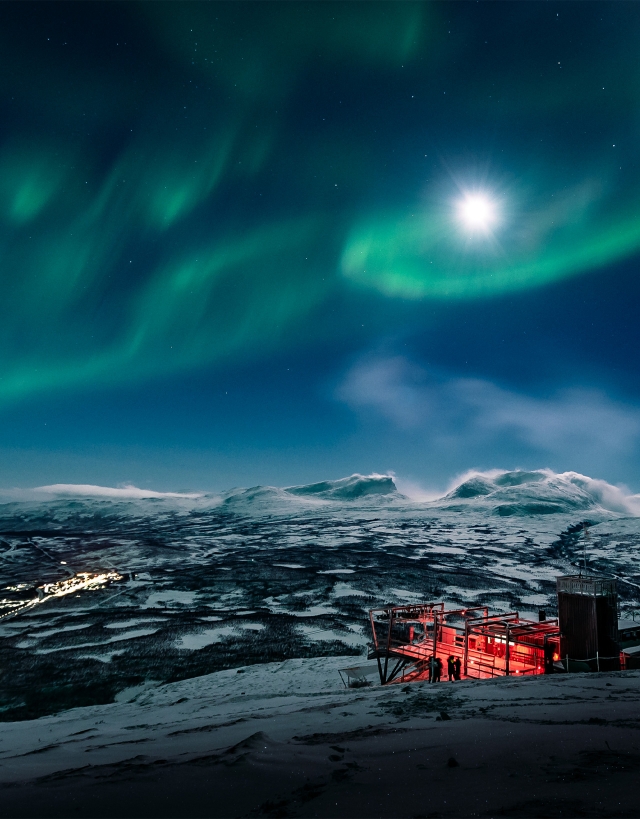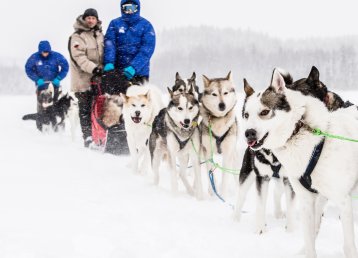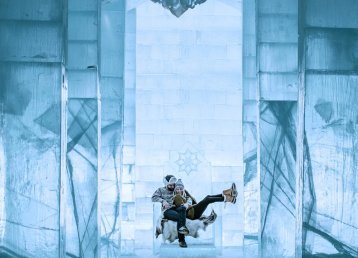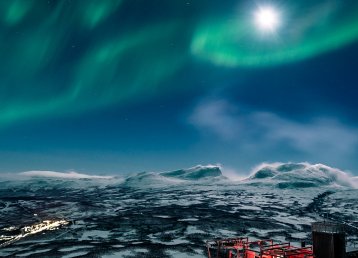The coast up north is pretty remarkable, this much is true. It actually grows, year by year. It’s to do with the inland ice. Post-glacial land elevation is the academic name for it, and it means that the land strives to return to its original level – the so-called mechanical rest position – after being subjected to extreme pressure by the inland ice during thousands of years.
– At its height, the landscape was covered by an ice sheet that was four kilometres thick, explains Peter Lundström from Swenature. Apart from offering traditional cray fishing and real nature experiences, he also enjoys working as a guide out by the coast in winter.
– The ice age ended around 10,000 years ago, and there’s still a lot left to remind us about it, the land elevation not the least. The uplift is greatest in West Bothnia and the land in Furuögrund, near Byske, rises the most. Almost 10 millimetres per year, says Peter as the forest opens up and he leads us straight out onto the sea ice.
An empty corner
We walk on snowshoes fitted with ice spikes, which is pretty handy. Even if the snow lay heavy on the trees on the way out the sea ice is windswept, and this makes it more slippery than soft.
– Some might call this inhospitable, Peter continues, but I really like it. When you step out of the forest and onto the sea, it’s like entering another world.
And of course, he’s right. The frozen sea is undoubtedly grand: barren, windswept. But also absolutely amazing. We set our sights at a lone island some distance away. The little lighthouse is all that reminds us that we’re not on top of a massive mountain plateau above the tree line or a glacier far away from the rest of the world. A sea eagle suddenly takes off, as if to point out that we’re nowhere but here – in an empty corner of the Bothnian Bay archipelago.
A mountain plateau above the tree line
Peter is pulling a sledge packed with all you need for a cosy day out on the sea: ice drill, reindeer skin, rods for ice fishing. Food and drink. We move leisurely over the ice, following the island’s north shoreline. We come across a wall of ice that rises high above our heads. The architecture of nature has certainly managed to surprise us somewhat.
– Just wait till we get to the other side, says Peter and smiles.
The wind increases and the snow starts falling more heavily.
–The likelihood of seeing the northern lights tonight is minimal, he says, but as you can see this is a good spot for northern lights watching. As long as there are no clouds.
Once we’ve rounded the north-eastern corner of the island, the landscape changes yet again. Now it’s no longer a mountain plateau above the tree line; what greets us is more like a barren moon landscape. Here, pack ice reigns.
– This is what happens when wind forces the ice floes, compressing massive amounts of ice.
Pack ice
Apart from providing us with a striking view, the pack ice also gives shelter from the wind. We climb down behind a little iceberg and find an ice floe sticking straight out – at the perfect hight to make a seat!
– Here we can rest, Peter says and unfastens the sledge.
Before he gets started on the cooking, he drills three holes in the ice and hands us the ice-fishing rods.
– You’ll provide the food, he laughs and says that there’s usually a fair amount of whitefish around.
As we sit ice fishing, Peter makes a fire, places the three-legged muurrikka skillet above the flames and places drinking cups and plates on an icy serving table.
– I have brought some palt (a kind of potato dumpling), he says if you’re unlucky with the fish.
Fried, home-made palt with lingonberry jam and butter. While the palt is cooking over the fire, Peter tells us that he found elk tracks covering a large area nearby the day before. Even leading far past the pack ice.
– It looked like something had been herding the elks. I found traces of a big canine as well. It’s unusual to get a wolf in this part of the country, but they’re seen here every now and then.
In winter the northern days are short. Before we’ve finished eating and packed everything away, it’s dark. We borrow head torches. Wrapped into the soft darkness of winter, light snowfall and experiences that keep us warm deep inside our duvet jackets we head back, towards the city lights.
Want to learn more?
Swenature organises a variety of real nature winter and summer experiences, as well as tours to the frozen sea. For more information, see swenature.se.
























